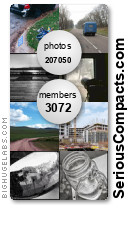I've gotten some emails expressing confusion regarding the difference between the multi-aspect ratio Four Thirds sensor in the Panasonic GH1 and the standard Four Thirds sensor found in all other Micro Four Thirds cameras. This illustration ought to clear it up.
On the left (first column), you can see the relative sizes of the GH multi-aspect ratio sensor (top) and the smaller standard Four Thirds sensor (bottom), each represented by white boxes.
In the second column, one can see that the portion of the GH1 sensor used for 4:3 aspect ratio (top) is the same size as the entire standard Four Thirds sensor (bottom). Thus the image captured will be the same when in 4:3 mode, regardless of whether one uses a standard Four Thirds or multi-aspect ratio sensor camera.
In the third and fourth columns, 3:2 and 16:9 respectively, the situation changes. Here, the GH1 uses the larger sensor to keep the lens diagonal angle of view unchanged regardless of aspect-ratio. In contrast, the standard Four Thirds sensor simply crops out a portion of the 4:3 capture to make the 3:2 or 16:9 image. As a result, the diagonal angle of view is less wide, and the megapixel count drops to a greater extent.
Illustration: Multi-Aspect Four Thirds Versus Standard Four Thirds
Thursday, October 8, 2009
Click for larger version
Illustration: Multi-Aspect Four Thirds Versus Standard Four Thirds
2009-10-08T05:46:00-05:00
Amin
Subscribe to:
Post Comments (Atom)
Recent Posts
-
▼
2009
(119)
-
▼
October
(10)
- Adobe Lightroom 3 Beta Noise Reduction
- 'Best Camera' iPhone Application
- Serious Use of Compact Camera Images in Graphic De...
- Sunday Thoughts about Gear Obsession
- Real-life ISO 1600: Panasonic GH1, G1, and Canon S90
- Canon S90 Barrel Distortion
- Canon Powershot S90 IS Initial Impressions: Build ...
- Canon S90 Now In Stock at Some Stores
- Illustration: Multi-Aspect Four Thirds Versus Stan...
- Micro Four Thirds Camera Comparison Table
-
▼
October
(10)


